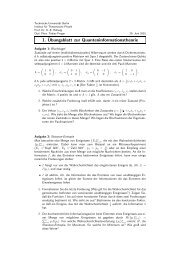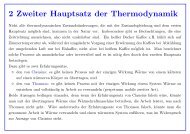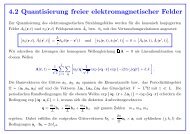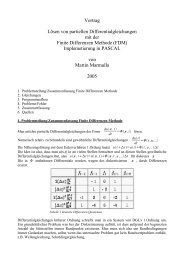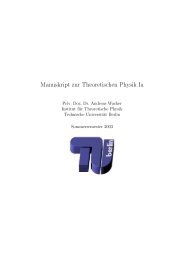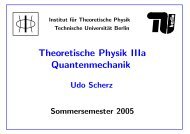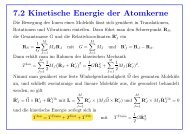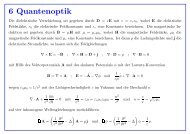1.1 The Radiation Laws and the Birth of Quantum Mechanics
1.1 The Radiation Laws and the Birth of Quantum Mechanics
1.1 The Radiation Laws and the Birth of Quantum Mechanics
You also want an ePaper? Increase the reach of your titles
YUMPU automatically turns print PDFs into web optimized ePapers that Google loves.
QUANTUM MECHANICS I (Dr. T. Br<strong>and</strong>es): Example/Solution Sheets 8<br />
2. If E < V , k becomes imaginary <strong>and</strong> we write<br />
√<br />
2m<br />
k = iκ := i (V − E) (2.33)<br />
2 with <strong>the</strong> real quantity κ. <strong>The</strong> two independent solutions <strong>the</strong>n become exponential functions e ±κx .<br />
Such solutions are called exponential solutions.<br />
For fixed energy E, <strong>the</strong> general solution ψ(x) will be a superposition, that is a linear combination<br />
ψ(x) = ae ikx + be −ikx (2.34)<br />
with k ei<strong>the</strong>r real or imaginary, k = iκ. Since <strong>the</strong> wave function in general is a complex function,<br />
<strong>the</strong> coefficients a, b can be complex numbers. Note that we can not have linear combinations with<br />
one real <strong>and</strong> one imaginary term in <strong>the</strong> exponential like ae ikx + be −κx , a, b ≠ 0.<br />
2.7 <strong>The</strong> Infinite Potential Well<br />
2.7.1 Energies <strong>and</strong> Eigenstates I (10-20 min)<br />
Consider <strong>the</strong> motion <strong>of</strong> a particle <strong>of</strong> mass m within <strong>the</strong> interval [x 1 , x 2 ] = [0, L], L > 0 between<br />
<strong>the</strong> infinitely high walls <strong>of</strong> <strong>the</strong> potential<br />
⎧<br />
⎨ ∞, −∞ < x ≤ 0<br />
V (x) = 0, 0 < x ≤ L<br />
(2.35)<br />
⎩<br />
∞ L < x < ∞<br />
Show that <strong>the</strong> normalized energy eigenstate wave functions <strong>and</strong> energies are<br />
√<br />
2<br />
( nπx<br />
)<br />
ψ n (x) =<br />
L sin , E = E n = n2 2 π 2<br />
, n = 1, 2, 3, ... (2.36)<br />
L<br />
2mL2 SOLUTION: (see lecture notes) Outside <strong>the</strong> interval [0, L] <strong>the</strong> particle can not exist <strong>and</strong> its wave<br />
function must be zero, i.e.<br />
⎧<br />
⎨ 0, −∞ < x ≤ 0<br />
ψ(x) = ae ikx + be −ikx , 0 < x ≤ L<br />
(2.37)<br />
⎩<br />
0, L < x < ∞<br />
We dem<strong>and</strong> that <strong>the</strong> wave function vanishes at x = 0 <strong>and</strong> x = L so that it is continuous a <strong>the</strong>se<br />
points. Clearly, this makes physically sense because at x = 0, L <strong>the</strong> potential is infinitely high <strong>and</strong><br />
<strong>the</strong> probability density |ψ(x)| 2 to find <strong>the</strong> particle <strong>the</strong>re should be zero. We obtain<br />
ψ(0) = 0 0 = a + b ψ(x) = c sin(kx), 0 ≤ x ≤ L, c = const.<br />
ψ(L) = 0 sin(kL) = 0. (2.38)<br />
<strong>The</strong> first condition tells us that <strong>the</strong> wave function must be a sine–function. <strong>The</strong> second condition is<br />
more interesting: it sets a condition for <strong>the</strong> possible values k n that k can have,<br />
kL = nπ k ≡ k n = nπ , n = 1, 2, 3, ... (2.39)<br />
L<br />
<strong>The</strong> second boundary condition at x = L restricts <strong>the</strong> possible values <strong>of</strong> <strong>the</strong> energy E, because<br />
k := √ (2m/ 2 ) (E − V ) = √ (2m/ 2 )E. <strong>The</strong>refore, <strong>the</strong> energy can only acquire values<br />
E n = 2 kn<br />
2<br />
2m = n2 2 π 2<br />
, n = 1, 2, 3, ... (2.40)<br />
2mL2




